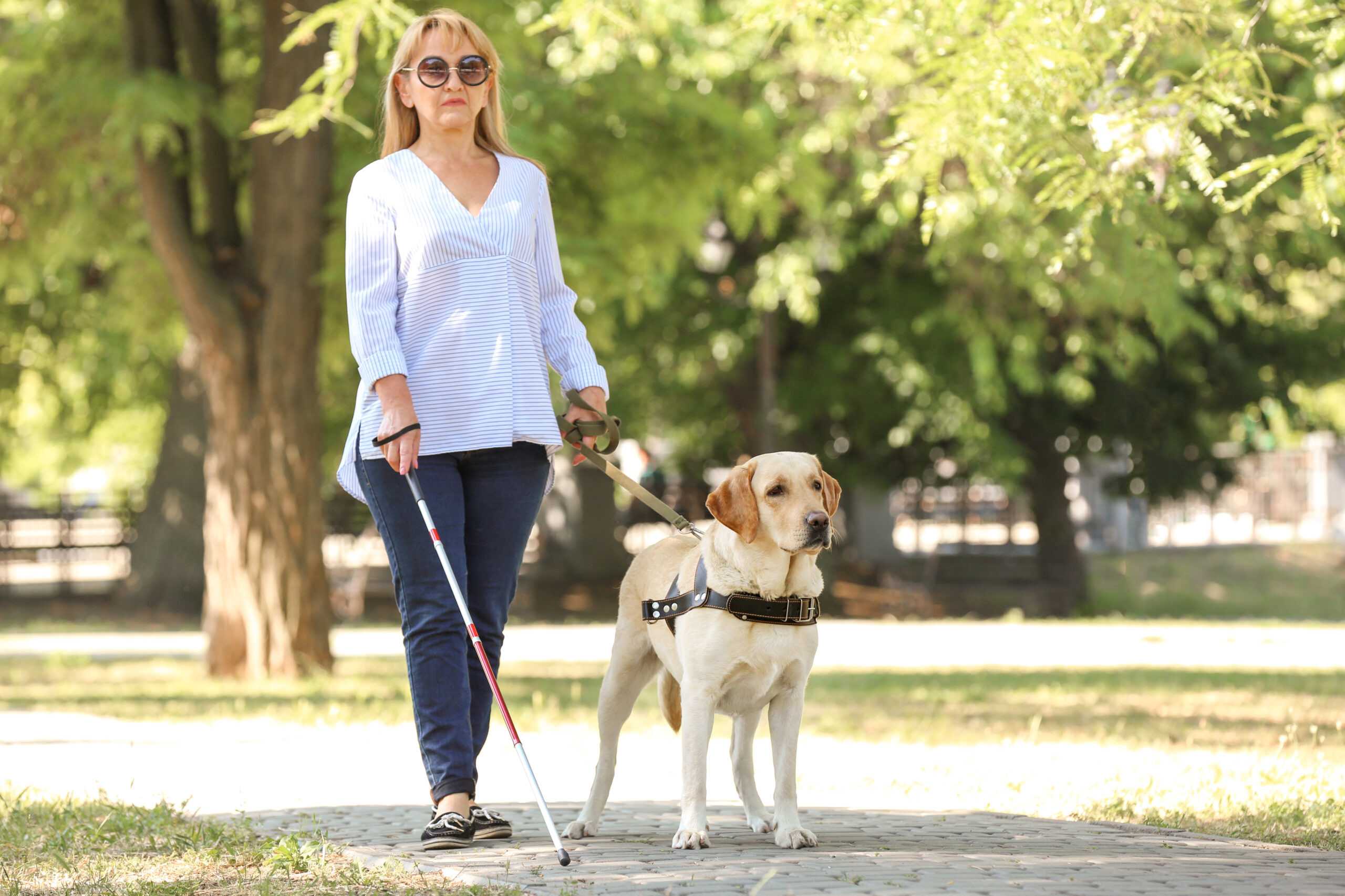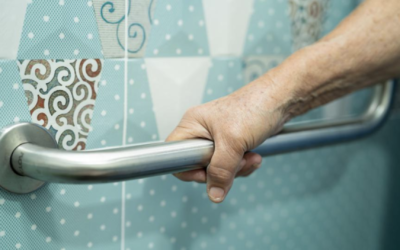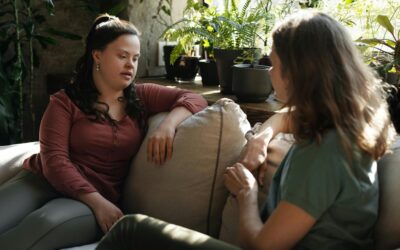Last month we shared about mental health, current rates and statistics, and how mental health uniquely impacts people with disabilities. We are privileged to continue sharing expert, firsthand information from a board member and a community member about autism and being autistic. In case you missed it, check out this amazing video.
This month, we will explore sensory loss. The primary forms of sensory loss are vision loss and hearing loss. People with both experience dual sensory loss. This week, we will introduce vision loss and hearing loss, or deafness. Later this month we will talk about dual sensory loss and Support Service Providers (SSPs) who assist individuals with dual sensory loss in navigating and living daily life.
Vision Loss

Image description: A blind man is pictured holding his walking cane. He is sitting on a grey couch, is wearing a dark grey jacket and white shirt. His eyes are clouded white. He has black curly hair, brown skin, and a beard.
According to the World Health Organization (WHO), approximately 253 million people worldwide live with vision impairment, 36 million of whom are blind. Vision loss disproportionately affects older adults, making it a growing public health concern as populations age. According to the International Agency for the Prevention of Blindness, age-related macular degeneration affects around 196 million individuals worldwide, primarily those aged 50 years and older.
People with vision loss often bear the weight of ableism due to misconceptions and stereotypes. There’s an assumption that individuals with vision loss are incapable of performing individual tasks or living independently. This misperception can lead to others excluding and marginalizing individuals with vision loss; or worse, seeing them as pitiful. The fact is that even though losing one’s vision can be a devastating and challenging life change, with the right skills training, support, and assistive technology or equipment, people with vision loss can and do live very fulfilling and independent lives.
Learning to navigate through our social infrastructure – buildings, streets, transportation, and even online – with vision loss can be daunting at first, as those systems have been designed for sighted people. However, over the decades we have made significant progress.
The Americans with Disabilities Act (ADA), for example, mandates accessibility for people with disabilities – including those experiencing vision loss – in public spaces, transportation, and the workplace. However, many buildings, workplaces, and other public areas are still not up to code with the ADA’s requirements.
Beth Gustin, a licensed mental health counselor who also is blind, explains the challenges she faces with accessibility.
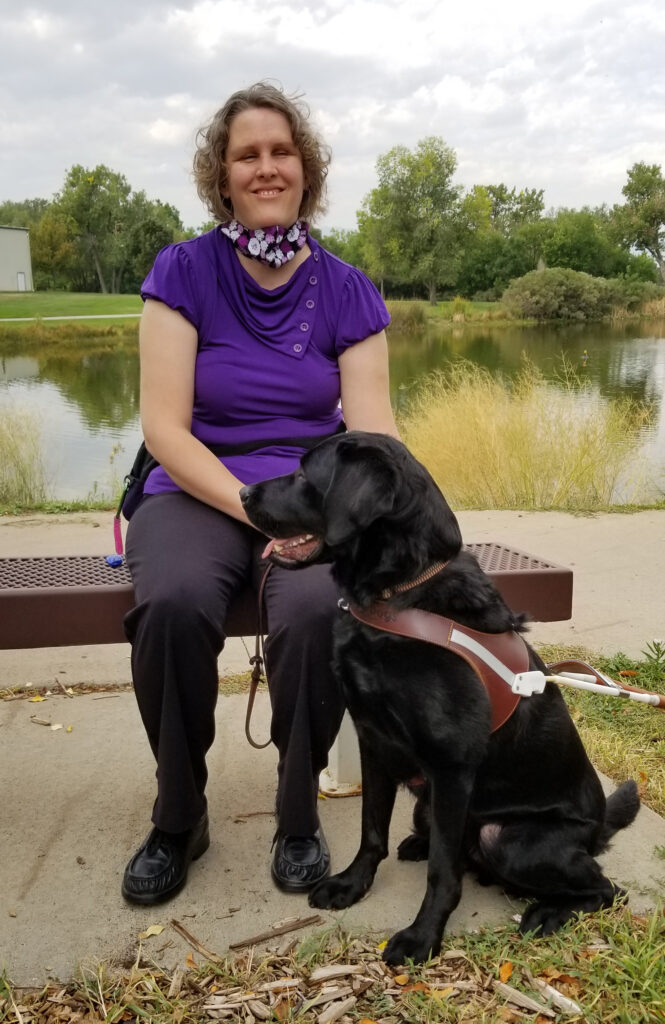
Image description: Beth Gustin is sitting on a bench outside. She is wearing a flowered scarf around her neck, a purple shirt, and black pants. She is smiling and has chin-length curly hair. In front of her is her black lab Manolo, who is her guide dog. Manolo is wearing a brown leather harness.
“I think there are strides being made, but at the same time I don’t think most people know: a) where to go to know how to make things accessible, and b) they don’t have resources to make it accessible, which is not okay, but it is what it is.”
Modern technology has delivered remarkable advancements and breakthroughs for individuals with vision loss. Innovations such as screen readers, braille displays, and accessible mobile applications have significantly improved accessibility, empowering people with vision loss to read, communicate, access information, track medications, and a host of other activities of daily living independently without needing assistance. However, limitations exist. For screen readers to work, every image or icon on a webpage needs a metatext that the software can “see” and read out loud to the user. And software and operating system updates can make previously effective versions of assistive technology suddenly nonfunctioning.
“Oftentimes some of the icons in the screen reader I use don’t have text labels, explains Guston. “If the icons aren’t labeled properly, I don’t know what they are, and I can’t fill out the forms properly,” she explained. “We make two steps forward and five steps back every time an app is updated or a website makes changes because things change so rapidly in the technology world, there’s no way a screen reader can keep up. And, we are primarily living in a sighted world, so of course things need to be visually appealing and easily accessible, and that isn’t always the case for those of us who navigate differently.”
Embracing the Positives
There are many positives for people with vision loss. Vision loss can heighten other senses, leading to a deeper appreciation for tactile experiences, music, and the beauty of the natural world. Gustin explains her experience being blind while working with clients in her therapy practice.
“My blindness gives me a different way of conceptualizing what my clients come in with. Because I can’t make eye contact with them, oftentimes clients will say they feel more comfortable that I don’t look at them directly. I think it can help build trust and rapport faster.
Individuals with vision loss can also develop exceptional spatial awareness and navigational skills, allowing them to move around with confidence and grace.
The book “An Immense World,” by Ed Yong, tells the story of Daniel Kish. Kish is the founder of the nonprofit World Access for the Blind. He was completely blind at 13 months of age after his eyes were removed due to aggressive cancer. He discovered, as a toddler, the profound ability to echolocate by clicking loudly with his tongue and listening intently to the reverberations of the sound. He uses a cane to detect immediate objects in front of him. Yet by constantly clicking his tongue as he walks down the street, he can tell where houses begin and end, where there are porches and shrubs, where cars are parked, and even if a low-hanging branch is about to hit him in the head. He calls this “touching with sound.” This ability allows him to walk around the city, go on solo hikes, and even ride his bike. His nonprofit helps teach this echolocation skill to other blind people. Kich was the first fully blind person in the United States to be certified as an orientation and mobility specialist. His story is a remarkable example of the unique abilities people with vision loss are capable of.
Technology and social and public places have made great strides in increasing accessibility over the past several decades. New laws are being proposed that could make it easier for people to report and request enforcement of ADA noncompliance, and new developments in assistive technology continue to increase access to digital dimensions for people with vision loss. And yet there is room to grow. As society as a whole learns more about sensory loss, our hope is that exclusion, ableism, and marginalization will be reduced, and replaced by inclusion, acceptance, and accessibility.
Hearing Loss
According to the World Health Organization, “disabling hearing loss” affects approximately 466 million people worldwide, which is more than 5% of the global population, 34 million of whom are children. The Centers for Disease Control and Prevention (CDC) reports that almost two out of every 1,000 children in the United States are born with hearing loss in one or both ears, making it one of the most common birth disabilities. Within the United States, around 15% of adults aged 18 and over experience some degree of hearing loss. By 2050, it is estimated that over 900 million people around the world will have disabling hearing loss, necessitating improved healthcare support and accessibility.
There are many misconceptions about individuals with hearing loss, or who are deaf. A common assumption is that individuals with hearing loss are less capable, less intelligent, and less competent. According to a survey conducted by the Hearing Loss Association of America, 68% of respondents with hearing loss reported experiencing negative stereotypes and misconceptions about their abilities, and 75% of adults with hearing loss have reported feeling left out or excluded in social gatherings or events due to their hearing loss. These statistics explain why, in addition to living with a disability and addressing communication barriers, individuals with hearing loss often face significant social isolation/inclusion challenges.
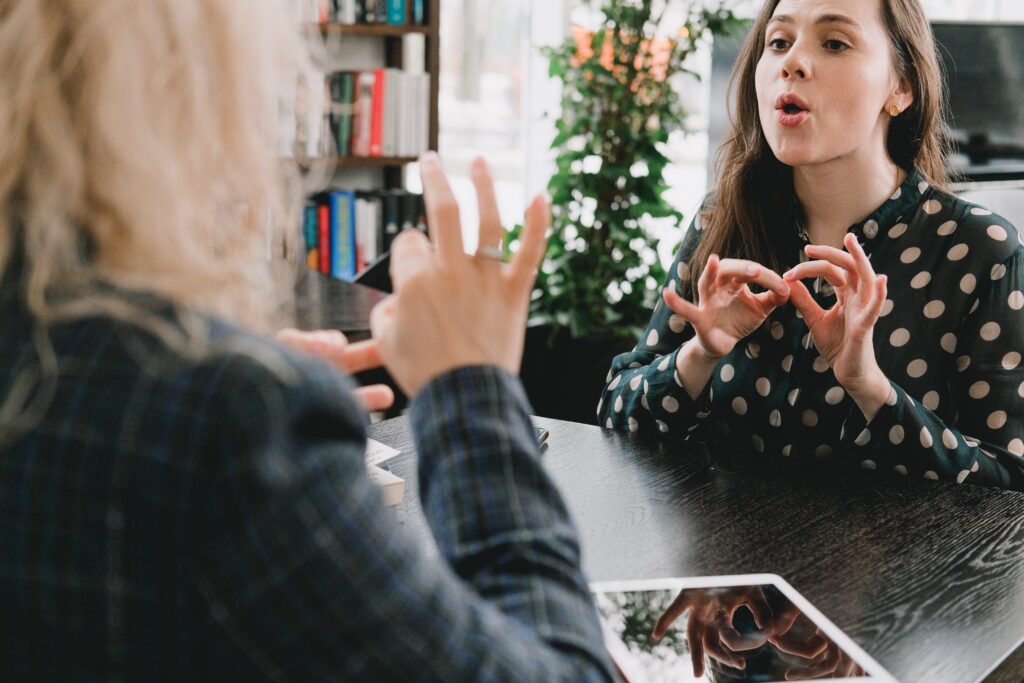
Image description: Two women sit at a table, speaking in sign language. One woman has her back to the camera. She has shoulder-length blond hair and a plaid grey shirt. The other woman has long brown hair and a polka-dot shirt. Behind them are a vase of flowers and a bookshelf.
Individuals with hearing loss also encounter challenges in the workplace, including discriminatory practices, and accessing public services. The National Deaf Center on Postsecondary Outcomes reports that individuals who are deaf or hard of hearing experience a higher unemployment rate (approximately 53%) compared to the general population. Research conducted by the University of Manchester found that individuals with hearing loss face obstacles during the hiring process, often encountering negative assumptions about their capabilities. A survey conducted by Action on Hearing Loss reported that 41% of individuals with hearing loss feel excluded from accessing public services due to poor communication support.
Individuals with hearing loss also encounter challenges in the workplace, including discriminatory practices, and accessing public services. The National Deaf Center on Postsecondary Outcomes reports that individuals who are deaf or hard of hearing experience a higher unemployment rate (approximately 53%) compared to the general population. Research conducted by the University of Manchester found that individuals with hearing loss face obstacles during the hiring process, often encountering negative assumptions about their capabilities. A survey conducted by Action on Hearing Loss reported that 41% of individuals with hearing loss feel excluded from accessing public services due to poor communication support.
The Positives
While hearing loss presents unique challenges, it is important to recognize that individuals with hearing loss possess remarkable strengths and abilities. Studies have shown that individuals with hearing loss often develop enhanced visual perception and nonverbal communication skills to compensate for their hearing loss. Research published in the Journal of Deaf Studies and Deaf Education showed that individuals with hearing loss demonstrate heightened visual attention and facial expression recognition abilities. A study published in the Journal of Speech, Language, and Hearing Research found that individuals with hearing loss display advanced cognitive and executive function skills, which can contribute to better problem-solving abilities.

Image description: Two women hug. Both are wearing black t-shirts. One woman has black hair and dark skin. The other woman has brown hair and light skin.
Many individuals with hearing loss exhibit exceptional empathy and active listening skills due to their heightened sensitivity to communication nuances. Their need to pay close attention to visual and contextual cues during conversations develops active listening skills, leading to a deeper understanding of others’ perspectives. Research published in the Journal of Deaf Studies and Deaf Education also showed that individuals with hearing loss often have a greater capacity for empathy and understanding due to their own experiences with communication challenges.
Vision loss and hearing loss bring specific challenges to people, not the least of which is dealing with discriminatory attitudes, communication barriers, and exclusionary practices. They also bring barriers to access in the areas of navigating physical society, digital information, communication and activities of daily living. Fortunately, the ADA and other accessibility laws and requirements are gradually being implemented and enforced, increasing access to areas of public and private life for people with vision loss and hearing loss. There is still work to be done, but recent years have shown great improvement over historical circumstances.
In terms of addressing discrimination, it’s up to all of us to challenge negative stereotypes, provide positive education and foster understanding, and promote inclusivity personally and professionally. Together, we can create a more inclusive and equitable world where the abilities and contributions of every individual are celebrated and respected.


